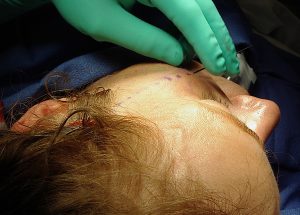Efforts to avoid undergoing facelift surgery are understandable from a patient’s viewpoint. This has lead to a wide variety of less surgical to non-surgical methods promoting variables degrees of facial rejuvenation outcomes. Whether it be tissue tightening, volume expansion or an actual lifting effect, the term facelift is often applied to these methods

In the March 2019 issue of the Aesthetic Surgery Journal an article was published on this topic entitled ‘Effectiveness, Longevity, and Complications of Facelift by Barbed Suture Insertion’. In his paper the authors review their experience in one hundred and sixty (160) patients who had site-specific facelifting done with barbed polydioxanone (PDO) sutures. Their technique used 2 or 3 PDO sutures (23 gauge) on each side for cheek augmentation and reduction of nasolabial grooves and 2 to 4 PDO sutures (21 gauge) in the treatment of mandibular lines.
Their results showed good improvement of facial soft tissue sagging at one month after the procedure. It was noticeable less so by six months and completely gone by one year after the procedure. Complications were primarily related to the barbed sutures was an occurrence of 34% (55/160 patients) An infection rate of 10%, skin dimpling (6%), superficial displacement of the implants (11%), and temporary redness (9%) were the primary problems seen.
The authors conclude that the short term effect of these facial lifting devices and the relatively high complication rate relegates their use to the patient who does not want or can not have a surgical facelift procedure.
This clinical study with good numbers and an honest assessment of the problems seen is not a surprise. This is the conclusion I came to years ago with the original Threadlift procedure. It is just the inherent nature of placing plastic devices in the superficial planes of the face. Behind the relatively high complication rate, the cost vs benefit analysis is probably equally discouraging. For many parents it may be far wiser to invest those resources in even limited forms of facelifting that can be done under local anesthesia or IV sedation.
Dr. Barry Eppley
Indianapolis, Indiana



